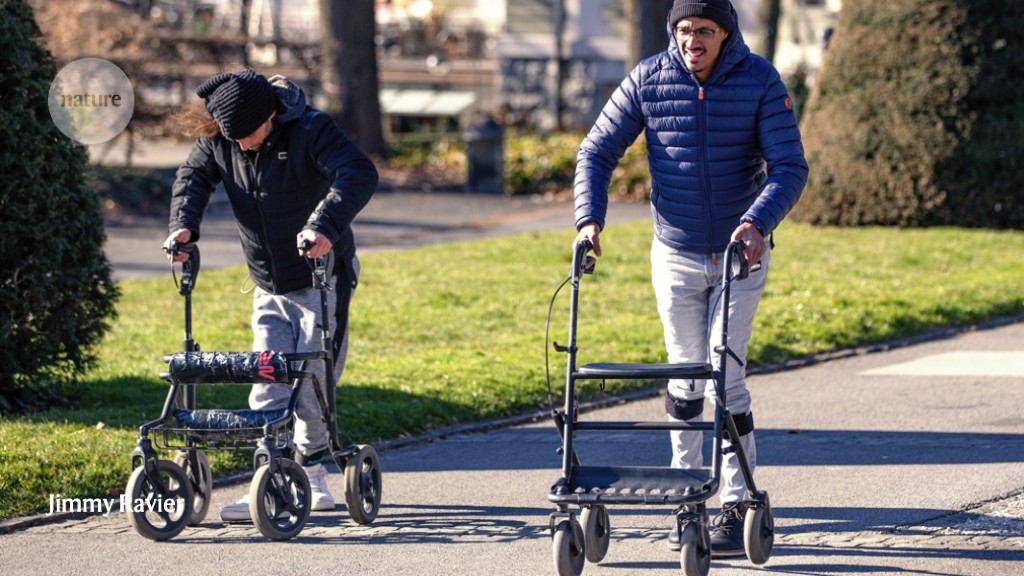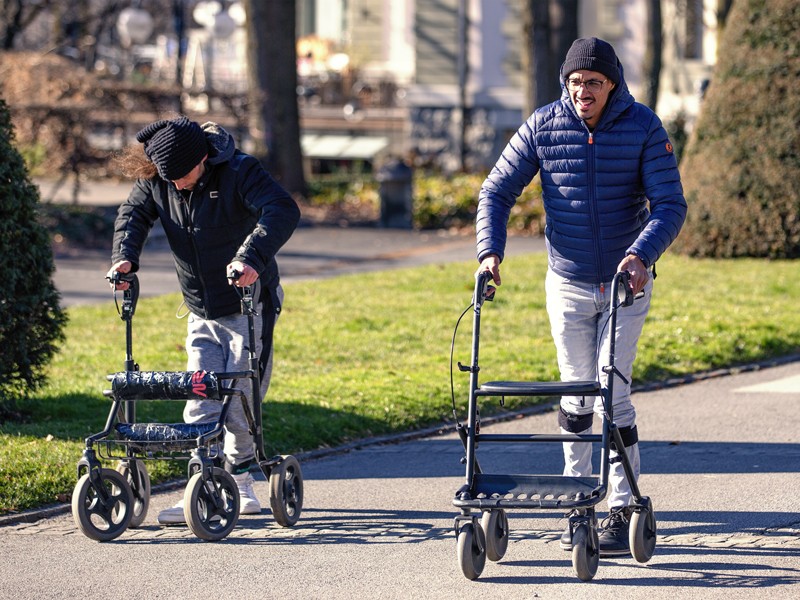Three people once paralysed by complete spinal-cord injuries can walk, swim, work the pedals of a bicycle and even paddle canoes, thanks to an implant that stimulates neurons in their spinal cords.
In a paper published on 7 February in Nature Medicine1, neuroscientist Grégoire Courtine at the Swiss Federal Institute of Technology in Lausanne (EPFL) and his colleagues describe the first implant specifically designed to control movement by mimicking the signals the lower body usually receives from the brain and upper spinal cord.
A completely severed spinal cord disrupts the electrical signals from the brain that tell parts of the body below the injury how to balance and move, resulting in paralysis that is usually irreversible. But the chain of motor neurons below the break often remains intact. Several research groups have been able to restore some movement in people with spinal-cord injuries by repurposing devices designed to block chronic pain by applying an electrical current to neurons.
Courtine’s group used magnetic resonance imaging and computed tomography to map the size and layout of the neurons in the spinal cords of 27 people, and created a predictive model of the average spinal cord. This helped to show a surgeon where on the recipients’ bodies to place the implant’s electrodes. The researchers then fine-tuned the electrical current to each individual. A team including EPFL neurosurgeon Jocelyne Bloch implanted the device into three people whose spinal cords had been completely severed, causing paralysis in the lower body.
Once the implant was in place, each person could control the pattern of electrical stimulation, using buttons and a tablet to raise or lower each leg, for example. All three participants recovered some level of movement within one day of activating the implant, including being able to walk on a treadmill while their weight was supported. “The first few steps were incredible — a dream come true!” said one of the people to receive the treatment, Michel Roccati, in a press release. The participants were also able to take part in activities such as pedalling a bicycle and performing squats, and to keep their bodies stable while paddling canoes, using the device to guide their muscles through preprogrammed movements.
Integrated approach
Reggie Edgerton, an exercise physiologist at the University of California, Los Angeles, who is working on electrical stimulation for people with spinal-cord injuries, is impressed with the level of detail in the paper and says the approach does a good job of integrating the “micro” elements of directed, timed activation of particular neurons with the “macro” scale of ensuring that the whole body is in tune with the movement. “You don’t walk just with your legs,” he says.
Edgerton’s own method uses electrodes applied to the skin to activate spinal neurons externally, which he says might provide a less invasive solution — or at least be a stopgap until an injured person can be implanted with a permanent device. The next question, he says, is whether stimulation over a long time will help the motor neurons to grow the correct connections to carry out the movement without the stimulation.
“It’s really exciting,” says Megan Gill, a physical therapist at Mayo Clinic in Rochester, Minnesota, who also works on electrical-stimulation devices for spinal-cord injury. Gill points out that the people in the study were not fully “walking” within one day of treatment — much of their weight was still supported — but she is impressed by the stimulation’s effectiveness.
Neurosurgeon Peter Grahn, also at Mayo Clinic, adds that the device’s ability to stimulate various neurons strategically, rather than continuously as previous devices have done, will help researchers to understand the dynamics of spinal-cord signalling. This could aid future efforts to restore movement to people who have also lost upper-body movement — a much more complex process.
Courtine says that his group hopes to simplify the technology so that a user can control it through a smartphone. The team has received approval from the US Food and Drug Administration to test the system in a US-based clinical trial with more people. Courtine says the researchers plan to focus on people with recent injuries, because tests in rodents have shown that animals tend to recover more motion when the stimulation begins immediately after their injury. They are also testing a brain implant that would directly route mental instructions to the spinal-cord-stimulation machinery. This device might restore other functions often lost because of a spinal-cord injury, such as bladder control and sexual function.
The work will give many people with spinal-cord injuries “reason to have a lot of hope”, Edgerton says.





More News
Daily briefing: Carrion crows have counting skills seen only in people
Researcher parents are paying a high price for conference travel — here’s how to fix it
Asymmetric hydrogenation of ketimines with minimally different alkyl groups – Nature